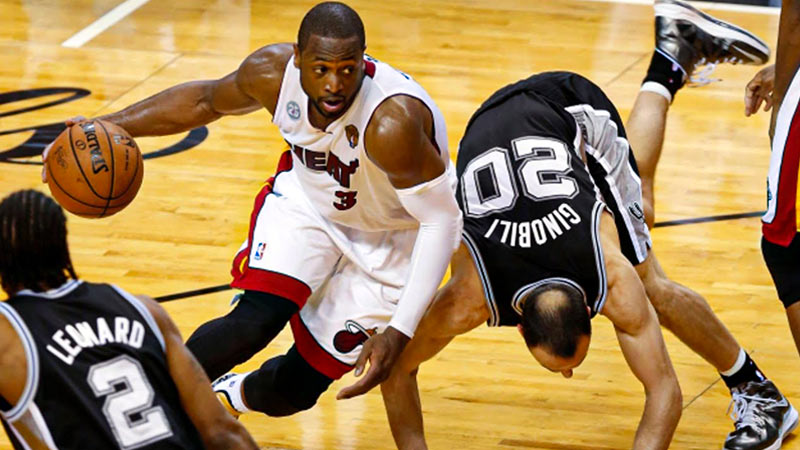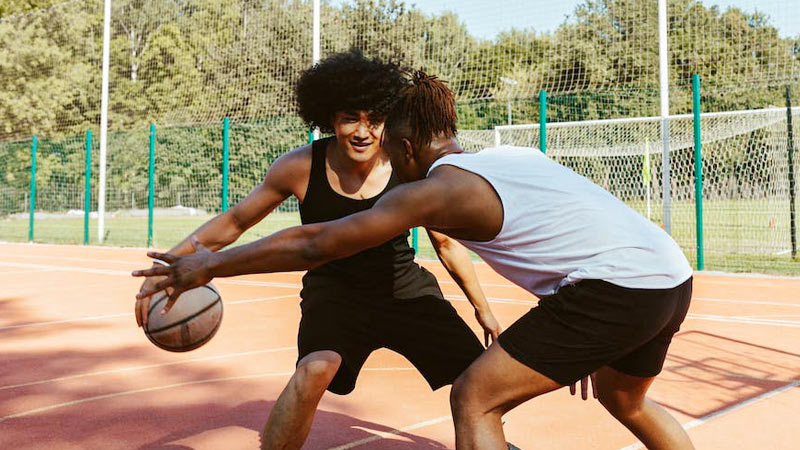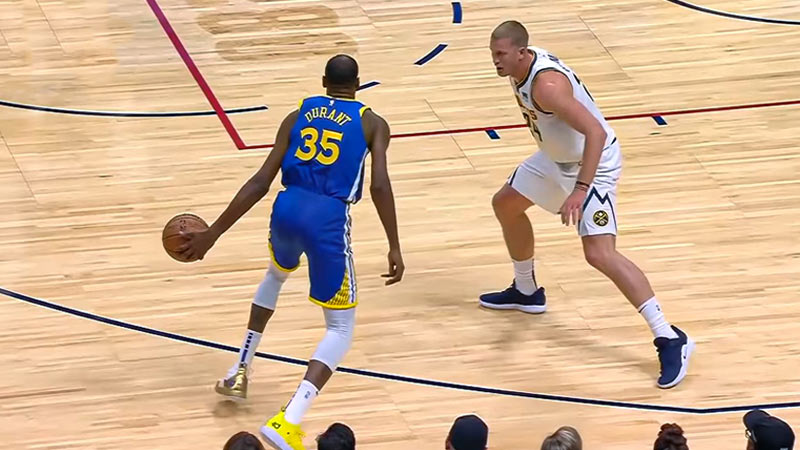Basketball is a sport known for its fast-paced action, athleticism, and incredible displays of skill. One move that has become increasingly popular and effective in recent years is the Euro step.
But what is a Euro Step in basketball? The Euro step is a technique used by players to navigate around defenders and create scoring opportunities near the basket.
It has become a signature move for many elite players and has revolutionized the way offensive players approach the game. Read on to learn more.
What Is a Euro Step in Basketball?
A Euro step is a basketball move where a player, typically while driving towards the basket, takes a quick sideways step in one direction and then a second step in the opposite direction to evade a defender and create space for a shot or a pass.
It is often used to avoid contact and finish at the rim with a layup or a dunk. The Euro step is commonly associated with European players, hence its name, but it is now widely used by players from all over the world.
The Euro step is believed to have originated in European basketball and was popularized by European players before finding its way into the repertoire of NBA stars.
Manu Ginobili, a retired Argentine professional basketball player, is often credited with bringing the Euro step to the forefront of basketball consciousness.
Since then, players like James Harden, Dwyane Wade, and Luka Dončić have showcased their effectiveness on the biggest stages.
At its core, the Euro step is a move that involves two steps in different directions to deceive defenders and gain an advantage. It is typically executed while driving to the basket. Here’s a breakdown of the basic mechanics:
Initial Step
When a player picks up their dribble while driving towards the basket, they take an initial step in one direction, usually with the outside leg. This step is used to set up the defender and make them commit to guarding that direction.
Gather Step
After the initial step, the offensive player then takes a second step in the opposite direction, often with the inside leg. This step is crucial for creating space and avoiding the defender, as the offensive player uses their body to shield the ball from being stripped away.
Finish
Once the second step is taken, the offensive player gathers themselves and prepares to finish the play near the basket. This can involve a layup, a dunk, or a pass to an open teammate if the defense collapses.
Over time, the Euro step has evolved and been incorporated into various basketball moves. Players have added their own variations, such as adding a spin or crossover dribble before executing the step, to further deceive defenders and maximize their scoring opportunities.
How to Execute the Euro Step?

Executing the Euro step in basketball requires proper footwork, timing, and coordination. Here’s a step-by-step guide on how to execute the Euro step effectively:
Drive to the Basket
Start by dribbling towards the basket, attacking the defender. This could be off a fast break, in a one-on-one situation, or even in traffic during a half-court set.
Initial Step
As you approach the defender, take an initial step in one direction with your outside leg. This step is used to set up the defender and make them commit to guarding that direction. It can be a long step or a quick sidestep, depending on the situation and the defender’s positioning.
Gather Step
After taking the initial step, quickly transition into a second step in the opposite direction with your inside leg. This is the gather step, where you gather yourself and control the ball while simultaneously moving away from the defender.
It’s important to keep your body low and balanced during this step, using your arms and body to shield the ball from being stripped away.
Body Control
Maintain control of your body and the ball during the gathering step. This involves keeping your eyes up, staying balanced, and ensuring the ball is protected from the defender.
Proper body control is crucial for maintaining your momentum and positioning yourself for the finish.
Finish the Play
Once you’ve completed the gather step, you should be in a position to finish the play near the basket. This could involve a layup, a dunk, or a pass to an open teammate if the defense collapses. It’s important to read the defense and make the appropriate decision based on the situation.
What Makes a Euro Step Effective?

The Euro step is effective in basketball for several reasons, making it a valuable move in a player’s offensive arsenal. Here are the key factors that contribute to the effectiveness of the Euro step:
Deception and Misdirection
The Euro step is designed to deceive defenders and create confusion. By taking an initial step in one direction and quickly transitioning to a gathered step in the opposite direction, offensive players can catch defenders off balance.
The sudden change in direction often leads to the defender being out of position, providing the offensive player with a clear path to the basket.
Ability to Navigate Through Traffic
In a crowded and fast-paced game like basketball, the Euro step allows players to navigate through traffic and avoid shot-blocking defenders.
By shifting their momentum and using their body to shield the ball, offensive players can maneuver around defenders, reducing the risk of having their shots blocked or losing possession.
Creation of Space
The Euro step helps create space for the offensive player to operate near the basket. By swiftly changing direction, the offensive player gains an advantage by creating separation from the defender.
This space allows for more comfortable and uncontested scoring opportunities, increasing the chances of a successful finish.
Enhanced Finishing Options
The Euro step opens up various finishing options for offensive players. Once they’ve completed the gather step, players can choose to finish with a layup, dunk, or even a pass to an open teammate.
The Euro step’s ability to create separation from defenders allows for a higher degree of creativity and adaptability when finishing plays near the basket.
Adaptability to Different Positions
The Euro step can be used by players of all positions, from guards to forwards and even centers. It is not limited to a specific height or size, making it a versatile move that can be effective regardless of a player’s physical attributes.
This adaptability allows players in various positions to add the Euro step to their offensive repertoire, increasing their scoring potential.
Foul-Drawing Potential
Due to its deceptive nature and quick change of direction, the Euro step often puts defenders in compromising positions. Defenders may resort to fouling the offensive player to prevent an easy basket.
This makes the Euro step an effective move for drawing fouls and earning trips to the free-throw line, providing additional scoring opportunities for the offensive team.
Evolution and Creativity
The Euro step continues to evolve, with players adding their own variations and counters to keep defenders guessing.
By incorporating spins, crossovers, hesitations, or combining the Euro step with other moves, offensive players can further enhance its effectiveness and surprise defenders with their creativity.
Tips for the Perfect Euro Step

To execute a perfect Euro step in basketball, here are some valuable tips to keep in mind:
Practice Footwork and Coordination
The Euro step heavily relies on precise footwork and coordination. Work on developing your agility, balance, and quickness through drills and exercises that emphasize these aspects. This will help you execute the move smoothly and effectively.
Master the Timing
Timing is crucial when performing the Euro step. Practice recognizing the defender’s movements and making your move at the right moment to catch them off balance. This will allow you to maximize the effectiveness of the Euro step and create scoring opportunities.
Read the Defender
Pay close attention to how the defender reacts to your initial steps. Their movements will dictate which direction you should take your gather step. If the defender overcommits to one side, quickly transition to the opposite direction to exploit the opening.
Protect the Ball
When performing the Euro step, it’s important to shield the ball from the defender. Keep the ball on the side away from the defender, using your body and arms to create a barrier between the defender and the ball. This will reduce the chances of the defender stripping the ball away.
Stay Low and Balanced
Maintaining a low and balanced stance throughout the Euro step is crucial for proper body control and stability. Bend your knees, stay low to the ground, and keep your core engaged.
This will help you maintain your balance and control during the move, allowing for a smoother transition and finish.
Use Your Arms Effectively
Your arms play a significant role in the Euro step. Swing your arms in coordination with your steps to generate momentum and maintain balance. Your arm movement can also help deceive the defender, creating further confusion and opening up scoring opportunities.
Add Variations and Counters
Once you’ve mastered the basic Euro step, experiment with variations and counters to keep defenders guessing. Incorporate crossovers, spins, or hesitations before executing the Euro step to further deceive defenders and enhance your scoring opportunities.
Practice In Game-Like Situations
While practicing the Euro step in isolation is important, it’s equally crucial to practice in game-like situations. Incorporate defenders or simulate defensive scenarios to better replicate the conditions you’ll face during a game.
This will help you adapt and execute the Euro step effectively in real-game scenarios.
Remember, consistency and repetition are key to mastering the Euro step. Incorporate these tips into your training regimen and dedicate time to refine your footwork, timing, and overall execution.
With practice and perseverance, you can elevate your Euro step game and become a more effective offensive player.
Is the Euro Step Considered Traveling?
The Euro step, when executed within the bounds of the rules, is not considered traveling. However, it’s essential to understand and adhere to the specific rules and regulations of the basketball league or organization you are playing in.
Different leagues may have variations in the interpretation of traveling violations, so it’s important to be familiar with the specific rules that apply to your situation.
In the NBA, for example, the Euro step is generally permitted as long as the offensive player establishes their pivot foot before taking their two steps. The two steps typically consist of an initial step and a gather step in the opposite direction.
This is known as the “gather” or “two-step” rule. As long as the gather step is taken after the initial step and the pivot foot is maintained, it is considered legal.
It’s important to note that the Euro step can appear deceiving and may sometimes be mistaken for a traveling violation by referees or fans who are not familiar with the rules. However, when executed correctly within the rules, the Euro step is a legal move and an effective tool for offensive players.
To ensure that you execute the Euro step properly, it’s recommended to practice and develop a good understanding of the rules regarding traveling violations in your specific league or organization.
This will allow you to confidently use the Euro step as part of your offensive repertoire while staying within the boundaries of the game’s rules.
FAQs
Is the Euro step considered a legal move in basketball?
Yes, the Euro step is considered a legal move in basketball. It is widely used at all levels of the game, from youth basketball to professional leagues like the NBA.
However, it is important for players to execute the Euro step within the rules of the game, ensuring they establish their pivot foot before taking their two steps.
Can any player use the Euro step, or is it only suitable for certain positions?
The Euro step can be used by players of all positions, as long as they have the necessary agility and coordination. While it is commonly seen among guards and wing players who often drive to the basket, there have been big men who incorporate the Euro step into their game as well.
Are there any specific situations where the Euro step is particularly effective?
The Euro step is particularly effective when driving to the basket against shot-blocking defenders. By changing direction quickly and using their body to shield the ball, offensive players can avoid the defender’s outstretched arms and disrupt their timing.
Can the Euro step be countered by defenders?
Defenders can certainly try to counter the Euro step by anticipating the offensive player’s moves and staying balanced. Quick and agile defenders may be able to react and cut off the offensive player’s path, making it harder for them to execute the move effectively.
Are there any other similar moves to the Euro step?
There are several moves in basketball that share similarities with the Euro step. One notable move is the “pro hop,” where the offensive player gathers the ball and takes a quick jump step to change direction before finishing at the rim.
The “hesitation move” is another technique used to deceive defenders by momentarily pausing or slowing down before quickly accelerating in a different direction.
Final Words
That was all about what is a Euro Step in basketball. To summarize, the Euro step is a dynamic move in basketball that has become increasingly popular and effective in recent years.
By utilizing two steps in different directions, offensive players can deceive defenders and create scoring opportunities near the basket. It requires agility, coordination, and proper footwork to execute effectively.
As the game of basketball continues to evolve, the Euro step is likely to remain a valuable weapon in the arsenal of many players, providing an exciting and creative element to the sport.







